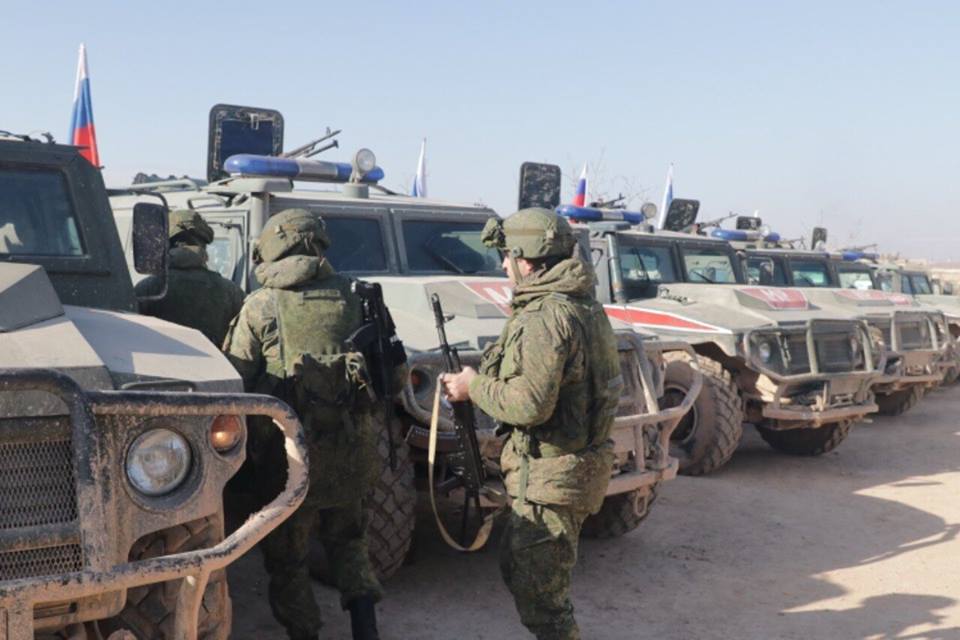Russian intervention in Syria 72 months on | Nearly 200 airstrikes strike nearly 35 positions in “de-escalation zone”
New attacks target Turkish-held areas in Aleppo countryside, while seven joint patrols with the Turks conducted in NE Syria
At a time when Russia’s plans are proceeding with their 72nd consecutive month of involvement in the Syrian crisis, the Syrian Observatory for Human Rights has monitored and tracked the recent developments during the tenth month of the sixth year of the Russian intervention in Syria. These key developments can be summarized regionally as follows:
North-east Syria
In the past month, Russian and Turkish forces conducted seven patrols, five of which were in Ain al-Arab countryside (Kobani) in Aleppo province on August 31, September 6, 13, 20 and 27. These five patrols set off from Ashma village in the west of Ain al-Arab and toured the villages and towns of Jarqili Fuqani, Qarran, Dikmidash, Kharkhouri, Boban, Seftek, Joul Bek and Zour Maghar village which is opposite Jarabulus city which is under the control of Turkish forces and their proxies on the eastern bank of the Euphrates river, and it is the furthest village in Ain al-Arab countryside.
While only one patrol toured al-Hasakah countryside on September 9, as the patrol set off from Sherek border crossing and took al-Darbasiyyah-Ras al-Ain road to Dalek and Salam Alik village. It is worth noting that the patrol could not continue its way to other villages, fearing of being attacked by the residents who gathered in some towns and villages in the western countryside of al-Darbasiyyah with Molotov cocktails in their hands waiting for the patrol. Meanwhile, Russian helicopters attempted to disperse the residents by firing smoke and stun grenade, but to no avail. Accordingly, the Russian and Turkish forces aborted the patrol and returned to the starting point.
The last patrol was conducted on September 2 and toured the villages of Derna Aghi, Atabah, Babasi, Kardim, Malla Abbas, Khushiniyyah and Alah Qous in al-Qamishli countryside.
North-west Syria
In the past month, Russian fighter jets escalated their airstrikes on the “de-escalation zone” considerably, targeting various positions in Idlib, Latakia, Aleppo and Hama countryside with over 204 airstrikes on 24 days. The Russian airstrikes were executed daily, except on September 16, 20, 27, 28, 29 and 30.
These airstrikes were distributed as follows: 154 airstrikes hit positions across Idlib province, 27 airstrikes were executed on Latakia province, four airstrikes were executed on Hama province and 19 airstrikes hit positions in Aleppo province.
The intensive Russian airstrikes hit positions in the following towns and villages:
- Idlib province: Sfuhen, al-Hamamah, Kansafrah, Uram al-Jouz, al-bara, the vicinity of Kafr Din, Sheikh Sandiyan, al-Faterah, Ain Larouz, Bruma, Maqla’ al-Habbat, the vicinity of Maarrat Masrin, the outskirts of Sheikh Bahr, Deir Sonbol, Zarzour, Balyoun, Mashoun, al-Kenda, Basamis, Iblin, Baynin, al-Ghassaniyah, al-Aliyah, Ain Shep, al-Ruwayha and the outskirts of al-Fu’ah.
- Hama province: Duwayr al-Akrad and al-Sarmaniyah in Sahl al-Ghab in the north-western countryside of Hama.
- Aleppo province: al-Sheikh Suleiman and the vicinity of Darat Izza in the western countryside of Aleppo.
- Latakia: Kabana, al-Khudur and Barzeh in Jabal al-Akrad in the northern countryside of Latakia.
The Russian airstrikes on the “de-escalation zone” left five people, including two children, dead, and they were distributed as follows:
- A Syrian child was killed in al-Bara on September 3.
- A Turkistani child was killed in Jisr al-Shughour countryside on September 15.
- A jihadi was killed in al-Kindah on September 18.
- Two jihadists, one of the Turkistani Islamic Party and the other of Hayyaat Tahrir al-Sham, were killed on September 24.
During the 72nd month of Russia’s military operations in Syria, Russian fighter jets carried out two attacks on Turkish-backed factions on Afrin, and these attacks were the first of their kind. The first attack was on September 25, as the Russian jets struck areas under the control of Turkish-backed factions in north-western Aleppo. According to SOHR sources, Russian jets executed five airstrikes on posts of the Turkish-backed “al-Jabha al-Shamiyyah” in Basofan and Basalihiyah areas in Shirawa district in the south-west of Afrin.
While the second attack was on the following day, on September 26, when Russian fighter jets executed headquarters and a camp of al-hamzah Division in Jabal al-Ahlam area in Afrin countryside, which resulted in the death of 11 militiamen of the Turkish-backed division and the injury of 13 others.
Syrian desert
In the 72nd month of military operations in Syria, SOHR activists document the death of 15 ISIS members and injury of 39 others in more than 1,390 Russian airstrikes on their positions in the Syrian desert, mostly killed in al-Raqqah desert, Deir Ezzor, Homs and Aleppo-Hama-al-Raqqah triangle.
As months pass, the Syrians suffer the scourge of the Russian intervention, which seems to resemble a kind of revenge and retaliation against Syrians for protesting against the regime that committed the worst violations against its own people. At a time when the map of alliances and power balances is changing, Russia has become the ultimate winner, succeeding in helping the Syrian regime regaining control over about two-thirds of the country after losing control of most of its territory. Moscow used the pretext of “the war on terror” to commit massacres against civilians, and sponsored and struck agreements which soon after abandoned. Moscow and its war machine spilt in the blood of Syrians despite claiming to be “political mediator” or “broker” that can deal with all parties to the conflict.
With all recent changes in the balance of powers, the Syrian Observatory for Human Rights renews its appeals to the international community to put pressure on Russia to stop its aggression against the Syrians, and to find a political solution to end the Syrian crisis that completed its tenth year.

